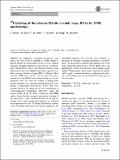| dc.contributor.author | Sochor, F. | |
| dc.contributor.author | Müller, D. | |
| dc.contributor.author | Richter, C. | |
| dc.contributor.author | Fürtig, B. | |
| dc.contributor.author | Schwalbe, H. | |
| dc.contributor.author | Silvers, Robert Paul Georg | |
| dc.date.accessioned | 2016-12-01T22:11:01Z | |
| dc.date.available | 2016-12-01T22:11:01Z | |
| dc.date.issued | 2015-12 | |
| dc.date.submitted | 2015-10 | |
| dc.identifier.issn | 0925-2738 | |
| dc.identifier.issn | 1573-5001 | |
| dc.identifier.uri | http://hdl.handle.net/1721.1/105512 | |
| dc.description.abstract | In comparison to proteins and protein complexes, the size of RNA amenable to NMR studies is limited despite the development of new isotopic labeling strategies including deuteration and ligation of differentially labeled RNAs. Due to the restricted chemical shift dispersion in only four different nucleotides spectral resolution remains limited in larger RNAs. Labeling RNAs with the NMR-active nucleus [superscript 19]F has previously been introduced for small RNAs up to 40 nucleotides (nt). In the presented work, we study the natural occurring RNA aptamer domain of the guanine-sensing riboswitch comprising 73 nucleotides from Bacillus subtilis. The work includes protocols for improved in vitro transcription of 2-fluoroadenosine-5′-triphosphat (2F-ATP) using the mutant P266L of the T7 RNA polymerase. Our NMR analysis shows that the secondary and tertiary structure of the riboswitch is fully maintained and that the specific binding of the cognate ligand hypoxanthine is not impaired by the introduction of the [superscript 19]F isotope. The thermal stability of the [superscript 19]F-labeled riboswitch is not altered compared to the unmodified sequence, but local base pair stabilities, as measured by hydrogen exchange experiments, are modulated. The characteristic change in the chemical shift of the imino resonances detected in a 1H,15N-HSQC allow the identification of Watson–Crick base paired uridine signals and the [superscript 19]F resonances can be used as reporters for tertiary and secondary structure transitions, confirming the potential of [superscript 19]F-labeling even for sizeable RNAs in the range of 70 nucleotides. | en_US |
| dc.description.sponsorship | Deutsche Forschungsgemeinschaft (collaborative research center: SFB902) | en_US |
| dc.publisher | Springer Netherlands | en_US |
| dc.relation.isversionof | http://dx.doi.org/10.1007/s10858-015-0006-9 | en_US |
| dc.rights | Article is made available in accordance with the publisher's policy and may be subject to US copyright law. Please refer to the publisher's site for terms of use. | en_US |
| dc.source | Springer Netherlands | en_US |
| dc.title | [superscript 19]F-labeling of the adenine H2-site to study large RNAs by NMR spectroscopy | en_US |
| dc.title.alternative | 19F-labeling of the adenine H2-site to study large RNAs by NMR spectroscopy | en_US |
| dc.type | Article | en_US |
| dc.identifier.citation | Sochor, F., R. Silvers, D. Müller, C. Richter, B. Fürtig, and H. Schwalbe. “19F-Labeling of the Adenine H2-Site to Study Large RNAs by NMR Spectroscopy.” J Biomol NMR 64, no. 1 (December 24, 2015): 63–74. | en_US |
| dc.contributor.department | Massachusetts Institute of Technology. Department of Chemistry | en_US |
| dc.contributor.department | Francis Bitter Magnet Laboratory (Massachusetts Institute of Technology) | en_US |
| dc.contributor.mitauthor | Silvers, Robert Paul Georg | |
| dc.relation.journal | Journal of Biomolecular NMR | en_US |
| dc.eprint.version | Author's final manuscript | en_US |
| dc.type.uri | http://purl.org/eprint/type/JournalArticle | en_US |
| eprint.status | http://purl.org/eprint/status/PeerReviewed | en_US |
| dc.date.updated | 2016-08-18T15:18:48Z | |
| dc.language.rfc3066 | en | |
| dc.rights.holder | Springer Science+Business Media Dordrecht | |
| dspace.orderedauthors | Sochor, F.; Silvers, R.; Müller, D.; Richter, C.; Fürtig, B.; Schwalbe, H. | en_US |
| dspace.embargo.terms | N | en |
| mit.license | PUBLISHER_POLICY | en_US |
